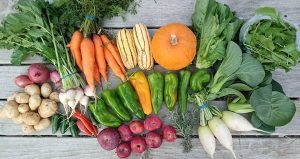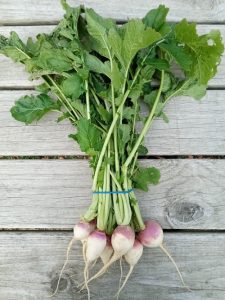
“The truth is rarely pure and never simple.”
~Oscar Wilde~
- Pie Pumpkin
- Delicata Squash
- Potatoes
- Red Onion
- Turnips
- Daikon Radish
- Carrots
- Apples
- Italian Frying Peppers
- Hot Peppers
- Romaine
- Greens Mix (arugula, mizuna, red kale, mustard, baby chard)
- Bok Choy
- Rosemary
Farmer Notes
With 2 nights at 20 degrees and days barely above freezing, we have spent an inordinate amount of time harvesting or covering crops in the field.
With a few frosts earlier in the week, it has been cemented in our heads that fall is firmly here and winter is rapidly approaching. These boxes are a reflection of that shift into autumn. Our boxes have placed an emphasis on root vegetables, and we have decided to highlight turnips as our crop of the week. The variety harvested this week was purple top turnips. Salad turnips will be present in the boxes next week. Turnips are commonly grown in temperate climates and are grown for their fleshy white taproot. Smaller, more tender varieties are grown for human consumption while the bigger ones can be used to feed livestock.
Wild forms of turnips have existed for over 2000 years in Western Asia and Europe. While the exact origins are unknown, people began cultivating edible turnips in medieval Europe and it was an important crop to Hellenistic and Roman societies. By 700 AD, the crop had spread to Japan and China. It was also an important staple in Antebellum America. With greens growing within two to three weeks, plantations were able to use those yields to sustain themselves when they were just getting off the ground.
Turnips are rich in fiber and B vitamins. Turnips can help regulate your blood sugar, and lower the amount of glucose created by the liver. When broken down, compounds in the turnip known as isothiocyanates are capable of inhibiting microbial and bacterial growth.
I love roasting turnips as part of a root vegetable medley. The creamy potato-like center just melts in your mouth when roasted, and is a nice contrast to the earthiness of beets and the sweetness of carrots. You can mash them up the same as you would potatoes for a savory staple winter dish. I usually do 50/50 turnips to potatoes for that. The greens are edible as well, and can be sauteed similar to beet greens. I hope everyone is enjoying the change of the seasons, and is taking the time to appreciate all they have done this year. Here’s to a great fall season!
-Farmer Dylan
Some Recipes To Try:
[ultimate-recipe id=”7039″ template=”default”]
[ultimate-recipe id=”10141″ template=”default”]
[ultimate-recipe id=”9396″ template=”default”]



